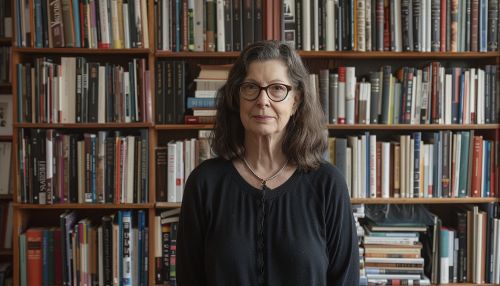Laura Mulvey: Difference between revisions
(Created page with "== Early Life and Education == Laura Mulvey was born on August 15, 1941, in Oxford, England. She attended St Hilda's College, Oxford, where she studied history. Mulvey's academic background in history provided a foundation for her later work in film theory and feminist critique. Her early exposure to the arts and humanities played a crucial role in shaping her intellectual pursuits. == Career and Contributions == === Feminist Film Theory === Laura Mulvey is best know...") |
No edit summary |
||
| Line 17: | Line 17: | ||
In addition to her theoretical work, Mulvey has been actively involved in avant-garde cinema. She collaborated with her husband, Peter Wollen, on several experimental films, including "Riddles of the Sphinx" (1977) and "Penthesilea: Queen of the Amazons" (1974). These films sought to challenge conventional narrative structures and visual styles, aligning with Mulvey's feminist critique of mainstream cinema. | In addition to her theoretical work, Mulvey has been actively involved in avant-garde cinema. She collaborated with her husband, Peter Wollen, on several experimental films, including "Riddles of the Sphinx" (1977) and "Penthesilea: Queen of the Amazons" (1974). These films sought to challenge conventional narrative structures and visual styles, aligning with Mulvey's feminist critique of mainstream cinema. | ||
[[Image:Detail-92055.jpg|thumb|center|Portrait of Laura Mulvey, a prominent feminist film theorist, standing in front of a bookshelf filled with books.|class=only_on_mobile]] | |||
[[Image:Detail-92056.jpg|thumb|center|Portrait of Laura Mulvey, a prominent feminist film theorist, standing in front of a bookshelf filled with books.|class=only_on_desktop]] | |||
== Major Works == | == Major Works == | ||
Latest revision as of 10:01, 18 June 2024
Early Life and Education
Laura Mulvey was born on August 15, 1941, in Oxford, England. She attended St Hilda's College, Oxford, where she studied history. Mulvey's academic background in history provided a foundation for her later work in film theory and feminist critique. Her early exposure to the arts and humanities played a crucial role in shaping her intellectual pursuits.
Career and Contributions
Feminist Film Theory
Laura Mulvey is best known for her seminal essay "Visual Pleasure and Narrative Cinema," published in 1975. This essay introduced the concept of the Male Gaze, a term that has since become foundational in feminist film theory. Mulvey argued that classical Hollywood cinema is structured around a masculine viewer, positioning women as passive objects of male desire. This concept challenged traditional notions of spectatorship and opened new avenues for analyzing gender dynamics in film.
Psychoanalytic Theory
Mulvey's work is deeply influenced by Psychoanalysis, particularly the theories of Sigmund Freud and Jacques Lacan. She utilized psychoanalytic concepts to explore how cinema constructs gendered identities. In "Visual Pleasure and Narrative Cinema," Mulvey employed Freud's theories of scopophilia (pleasure in looking) and Lacan's notion of the mirror stage to explain how films create visual pleasure through the objectification of women.
Avant-Garde Cinema
In addition to her theoretical work, Mulvey has been actively involved in avant-garde cinema. She collaborated with her husband, Peter Wollen, on several experimental films, including "Riddles of the Sphinx" (1977) and "Penthesilea: Queen of the Amazons" (1974). These films sought to challenge conventional narrative structures and visual styles, aligning with Mulvey's feminist critique of mainstream cinema.


Major Works
"Visual Pleasure and Narrative Cinema"
Published in 1975, "Visual Pleasure and Narrative Cinema" is arguably Mulvey's most influential work. The essay critiques the ways in which classical Hollywood cinema perpetuates patriarchal ideologies. Mulvey's analysis focuses on the mechanisms of voyeurism and fetishism, arguing that these cinematic techniques reinforce male dominance and female subordination.
"Afterthoughts on 'Visual Pleasure and Narrative Cinema'"
In 1981, Mulvey published "Afterthoughts on 'Visual Pleasure and Narrative Cinema' inspired by Duel in the Sun," which revisits her earlier arguments in light of subsequent feminist critiques. This essay addresses some of the limitations of her original work and explores the potential for female spectatorship within the framework of classical cinema.
"Death 24x a Second: Stillness and the Moving Image"
Published in 2006, "Death 24x a Second: Stillness and the Moving Image" examines the relationship between stillness and movement in cinema. Mulvey explores how digital technology has transformed the way we engage with film, allowing for new forms of spectatorship and analysis. This work extends her earlier theories into the digital age, highlighting the evolving nature of visual pleasure.
Influence and Legacy
Impact on Film Studies
Laura Mulvey's work has had a profound impact on the field of film studies. Her theories have been widely adopted and expanded upon by scholars, leading to the development of new critical frameworks for analyzing cinema. The concept of the male gaze, in particular, has become a central tenet of feminist film theory, influencing a wide range of academic disciplines.
Influence on Filmmaking
Mulvey's ideas have also influenced filmmakers, particularly those working within feminist and avant-garde traditions. Directors such as Chantal Akerman, Agnes Varda, and Sally Potter have drawn on Mulvey's theories to create films that challenge traditional representations of gender and sexuality. Her work has inspired a generation of filmmakers to explore new narrative forms and visual styles.
Criticisms and Debates
Limitations of the Male Gaze
While Mulvey's concept of the male gaze has been highly influential, it has also faced criticism. Some scholars argue that the theory is overly deterministic, reducing complex cinematic experiences to a binary opposition between male and female spectatorship. Others contend that Mulvey's focus on classical Hollywood cinema overlooks the diversity of film cultures and the potential for alternative forms of spectatorship.
Intersectionality
Another critique of Mulvey's work is its lack of attention to intersectionality. Critics argue that her theories do not adequately address the ways in which race, class, and sexuality intersect with gender in the construction of cinematic representations. This has led to calls for more inclusive and nuanced approaches to feminist film theory.
Later Work and Ongoing Research
In recent years, Laura Mulvey has continued to engage with contemporary issues in film and media studies. Her research has expanded to include topics such as digital technology, the archive, and the politics of memory. Mulvey's ongoing work reflects her commitment to exploring the evolving landscape of visual culture and its implications for feminist theory.
